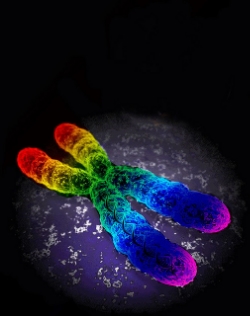From New Scientist:
Huge Twin Study Homes In On 'Gay Genes' by Andy Coghlan
A genetic analysis of 409 pairs of gay twins has provided the strongest evidence yet that gay people are born gay. The study clearly links sexual orientation in men with two regions of the human genome that have been implicated before, one on the X chromosome and one on chromosome 8.
The finding is an important contribution to mounting evidence that being gay is biologically determined rather than a lifestyle choice. In some countries, such as Uganda, being gay is still criminalised, and some religious groups believe that gay people can be "treated" to make them straight.
"It erodes the notion that sexual orientation is a choice," says study leader Alan Sanders of the NorthShore Research Institute in Evanston, Illinois.
The region on the X chromosome picked out by the study, called Xq28, was originally identified in 1993 by Dean Hamer of the US National Institutes of Health in Bethesda, Maryland, but attempts to validate the finding since have been mixed. The other region picked out is in the twist in the centre of chromosome 8. Known as 8q12, it was first signposted in 2005.
Statistically stronger
The latest study involves about three times as many people as the previous largest study, which means it is significantly more statistically robust.
Over the past five years, Sanders has collected blood and saliva samples from 409 pairs of gay non-identical twins from 384 families. This compares, for example, with 40 pairs of twins recruited for Hamer's study.
The team combed through the samples, looking at the locations of genetic markers called single nucleotide polymorphisms (SNPs) – differences of a single letter in the genetic code – and measuring the extent to which each of the SNPs were shared by the men in the study.
The only trait unequivocally shared by all 818 men was being gay. Because the twins were non-identical so don't have the same genes, all other traits, such as hair colour, height and intelligence, varied by different degrees between each twin in a pair and between all sets of twins. Therefore, any SNPs consistently found in the same genetic locations across the group would most likely be associated with sexual orientation.
Only five SNPs stood out and of these, the ones most commonly shared were from the Xq28 and 8q12 regions on the X chromosome and chromosome 8 respectively. But this doesn't mean the study found two "gay genes". Both regions contain many genes, and the next step will be to home in on which ones might be contributing to sexual orientation.
Sanders says he has already completed the work for that next step: he has compared SNPs in those specific regions in gay and straight men to see if there are obvious differences in the gene variants, and is now preparing the results for publication. "Through this study, we have the potential to narrow down to fewer genes," says Sanders.
Whatever the results, Sanders stresses that complex traits such as sexual orientation depend on multiple factors, both environmental and genetic. Even if he has hit on individual genes, they will likely only have at most a small effect on their own, as has also been seen in studies of the genetic basis for intelligence, for example.
